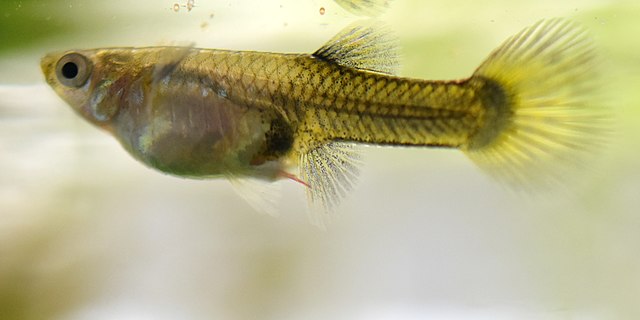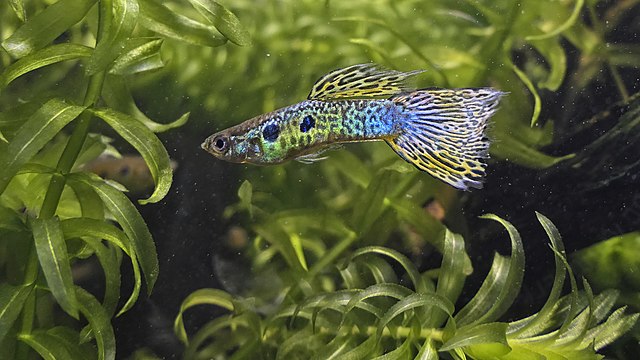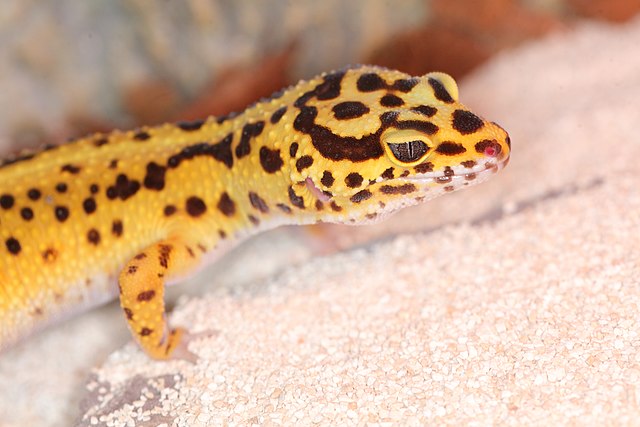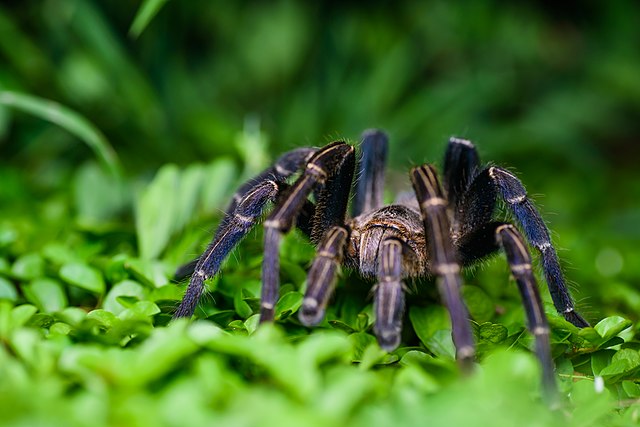A pregnant guppy, scientifically known as Poecilia reticulata, is a fascinating and delicate being that demands keen attention from aquarium enthusiasts. These small, vibrant fish are livebearers, meaning they give birth to fully formed young ones instead of laying eggs. Female guppies have the unique ability to store sperm for several months, allowing them to produce multiple batches of fry without additional mating.
Signs of a Pregnant Guppy
Witnessing the miracle of life in your aquarium begins with recognizing the subtle yet distinct signs of pregnancy in guppies. As these fascinating creatures go through the gestation period, they exhibit several physical changes that are indicative of their impending motherhood. By closely observing your female guppies, you can decipher these signs and prepare for the arrival of new life in your tank.
Swollen Abdomen
One of the earliest and most noticeable signs of pregnancy in guppies is a swollen abdomen. As the fry develop inside the mother’s body, her belly expands, creating a rounder and more pronounced appearance. This swelling becomes increasingly evident as the pregnancy progresses, making it a reliable indicator of impending birth.
Gravid Spot Darkening
Adjacent to the anal fin, female guppies possess a small, dark spot known as the gravid spot. This spot serves as a window to the guppy’s pregnancy. As the fry inside the mother grow, the gravid spot darkens. Initially light in color, it gradually deepens, becoming darker as the pregnancy advances. Observing this change provides valuable insight into the developmental stage of the fry.
Changes in Behavior
Apregnant guppy often exhibit changes in behavior. They might become slightly more reclusive, seeking out hiding spots or densely planted areas in the aquarium. This behavior is a natural instinct to protect themselves and their unborn fry from potential threats. Additionally, pregnant guppies might show a decreased interest in food as the pregnancy nears its end.
Restlessness and Fidgeting
As the delivery date approaches, you might notice your pregnant guppy displaying restlessness. She may fidget more, seemingly unable to find a comfortable position. This restlessness is a sign that the guppy is preparing for labor. During this time, providing a calm and secure environment is crucial to ensure a stress-free birthing process.
Visible Eyes
In some cases, you might be able to see the eyes of the developing fry through the translucent skin of the pregnant guppy’s abdomen. This fascinating phenomenon occurs in the latter stages of pregnancy and offers a glimpse into the tiny lives growing inside the mother.

By attentively observing these signs, you can not only confirm the pregnancy of your guppies but also anticipate the joyous moment when the fry are born. Providing a nurturing environment during this period of anticipation ensures the well-being of both the mother and her offspring, creating a thriving aquatic community within your aquarium.
Creating a Suitable Environment
Ensuring a comfortable and stress-free environment is paramount when caring for pregnant guppies. By mimicking their natural habitat and addressing their specific needs, you can provide an ideal setting for the gestation period, ensuring the health and well-being of both the mother and her fry.
Well-Planted Tank
Begin by setting up a well-planted aquarium. A pregnant guppy would appreciate an environment with ample vegetation. Live plants like java moss, hornwort, and Amazon sword provide not only hiding spots but also serve as a source of natural filtration, maintaining water quality. The presence of plants offers security to pregnant guppies, allowing them to retreat into the foliage when they feel vulnerable, thereby reducing stress.
Adequate Hiding Places
Incorporate various hiding places within the tank, such as caves, PVC pipes, or decorative ornaments with hollow spaces. Pregnant guppies, especially when close to giving birth, seek seclusion. These hiding spots offer a sanctuary where they can rest and feel secure, ensuring a stress-free environment. Ensure these hiding places have no sharp edges to prevent injury to the delicate guppy fins.
Stable Water Parameters
Maintaining stable water parameters is crucial for a pregnant guppy. Fluctuations in temperature, pH, or hardness can induce stress, potentially leading to complications during pregnancy. Regularly monitor these parameters using reliable aquarium test kits and make adjustments as necessary. The water temperature should ideally be between 74°F to 82°F (23°C to 28°C) to promote optimal gestation and growth of the fry.
Proper Filtration and Aeration
Invest in a good filtration system suitable for your aquarium size. Efficient filtration helps remove impurities and ensures the water remains clean and oxygenated. Additionally, consider gentle aeration using air stones or sponge filters. Proper oxygenation is vital, especially in densely planted tanks, as it aids in the respiration of both the pregnant guppies and their developing fry.
Regular Water Changes
Perform regular partial water changes to maintain high water quality. Removing a portion of the water and replacing it with dechlorinated, temperature-matched fresh water helps dilute toxins and ensures a healthy environment for the guppies. Aim for weekly water changes of about 20-30% to keep the water pristine, promoting the well-being of your aquatic pets.
Dim Lighting
Consider providing a subdued lighting environment. Guppies, including the pregnant ones, appreciate dim lighting, which mimics their natural habitat. Use LED lights with adjustable brightness settings or place floating plants like water lettuce or frogbit to create patches of shade. This dim lighting not only reduces stress but also enhances the vibrant colors of your guppies, making your aquarium visually appealing.

By carefully curating the aquarium environment to meet the specific needs of a pregnant guppy, you create a haven where they can thrive, ensuring a successful pregnancy and the healthy development of the fry.
Nutritional Requirements
Providing a well-balanced and nutrient-rich diet is paramount when it comes to the health and vitality of pregnant guppies. Proper nutrition not only supports the mother during her pregnancy but also ensures the robust development of the fry, setting the stage for a thriving aquatic community. Understanding the dietary needs of pregnant guppies and catering to those requirements is essential for their overall well-being.
High-Quality Flakes and Pellets
Offer a high-quality staple diet of flakes and pellets specifically formulated for tropical fish. Look for products that contain a variety of proteins, vitamins, and minerals. These commercial foods serve as the foundation of a guppy’s diet and provide essential nutrients required for growth and reproduction.
Live Foods
Supplement their diet with live foods, which are rich in proteins and highly enticing for guppies. Daphnia, brine shrimp, and mosquito larvae are excellent choices. Live foods mimic the guppy’s natural diet in the wild and are particularly beneficial for a pregnant guppy as they provide abundant protein essential for the development of both the mother and the fry.
Vegetables and Spirulina
Incorporate vegetable-based foods into their diet. Guppies, despite being primarily carnivorous, benefit from the fiber and nutrients found in vegetables. Spirulina flakes or blanched vegetables like spinach, zucchini, or cucumber can be offered occasionally. These foods aid in digestion and contribute to the overall balance of their diet.
Specialized Guppy Fry Food
As the pregnancy progresses, consider introducing specialized guppy fry food. These tiny, nutrient-dense particles are specifically designed for the fry’s small mouths. Rich in proteins, vitamins, and minerals, these foods support rapid growth and development. They come in various forms, such as powdered or liquid, ensuring that even the smallest fry can consume them.
Regular Feeding Schedule
Establish a consistent feeding schedule. Pregnant guppies, like other fish, thrive on routine. Feed them small portions multiple times a day, rather than one large meal. This approach ensures that the guppies receive an adequate supply of nutrients without overfeeding, which can lead to water quality issues.
Variety is Key
Vary their diet to prevent nutritional deficiencies. Offering a diverse range of foods not only keeps your guppies excited about feeding time but also ensures they receive a spectrum of nutrients. A varied diet contributes to their overall health, enhancing their colors, vitality, and reproductive capabilities.

By providing a well-rounded and diverse diet that caters to the specific nutritional needs of pregnant guppies, you are investing in the longevity and vibrancy of your aquatic pets. A balanced diet not only supports the guppies during pregnancy but also paves the way for healthy fry, ensuring the continuation of this captivating and delightful species within your aquarium.
Handling Baby Guppies
The arrival of baby guppies in your aquarium is a momentous occasion, filled with wonder and excitement. However, ensuring the safety and well-being of these delicate fry requires careful handling and thoughtful consideration. Here’s a comprehensive guide on how to handle baby guppies to guarantee a safe start to their lives:
Separating the Fry
As soon as the pregnant guppy gives birth, it’s imperative to separate the fry from adult fish to prevent predation. There are various methods to achieve this, such as using a breeding box or setting up a dedicated fry tank. Breeding boxes, which float inside the main tank, provide a secure space for the fry to acclimate to the water conditions of the main tank while being protected from larger, potentially predatory fish.
Alternatively, a separate fry tank equipped with gentle filtration offers a more spacious environment for the fry to grow and develop without any threat from adult guppies.
Providing Appropriate Nutrition
The nutritional needs of baby guppies differ significantly from those of adults. Initially, baby guppies rely on their yolk sacs for nourishment, but they quickly transition to external food sources. Offer finely crushed high-quality flakes or specialized guppy fry food. Newly hatched brine shrimp is also an excellent protein source for growing fry. These foods are rich in essential nutrients and support the rapid growth and development crucial for their survival.
Maintaining Stable Water Parameters
Consistently monitor and maintain stable water parameters in the fry tank. Ammonia and nitrite levels should be kept at zero, and the water temperature should be between 74°F to 82°F (23°C to 28°C). Regular water changes, typically around 20-30% weekly, are essential to ensure clean, oxygenated water. Stable parameters are vital for the overall health and development of the fry.
Providing Adequate Hiding Places
Even in their own space, fry benefit from hiding spots. Use fine-leaved plants or commercial breeding nets to create safe havens where the fry can retreat. These hiding spots not only offer protection but also reduce stress, allowing the fry to feed and grow without fear of predation.
Observing Growth and Behavior
Regularly observe the growth and behavior of the fry. Healthy fry exhibit active swimming patterns, eagerly explore their environment, and display vibrant colors. Keep an eye out for any signs of illness or distress, such as clamped fins or lethargic behavior. Early detection of issues allows for timely intervention, ensuring the well-being of the fry.
Gradual Introduction to Main Tank
Once the fry have grown large enough to avoid being seen as prey by adult guppies, usually when they reach a size of around 1 inch (2.5 cm), they can be gradually introduced back into the main tank. However, ensure that the main tank inhabitants are not aggressive and that there are plenty of hiding spots to allow the young guppies to acclimate safely.
Handling baby guppies requires patience, vigilance, and a nurturing attitude. By providing a secure environment, appropriate nutrition, and careful observation, you play a crucial role in ensuring the survival and prosperity of these tiny, enchanting creatures.
Conclusion
Caring for a pregnant guppy is a fulfilling endeavor that allows aquarium enthusiasts to witness the miracle of life within their own tanks. By understanding their unique reproductive biology, recognizing the signs of pregnancy, providing a suitable environment, offering proper nutrition, and safeguarding the fry through appropriate handling, you can ensure the well-being of your guppies and enjoy generations of these captivating fish in your aquarium.








